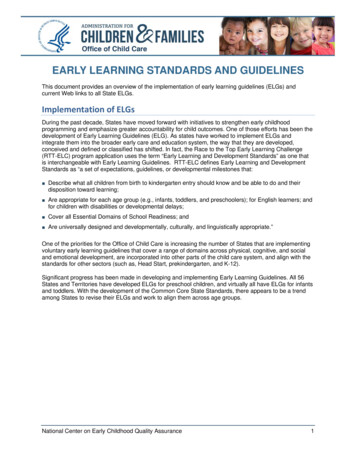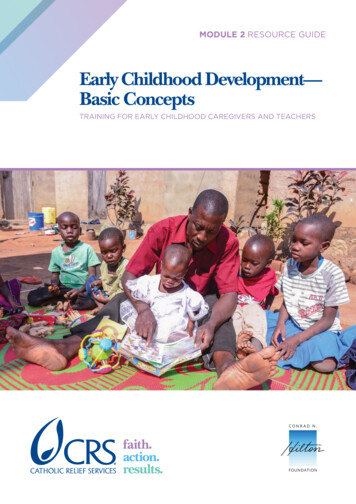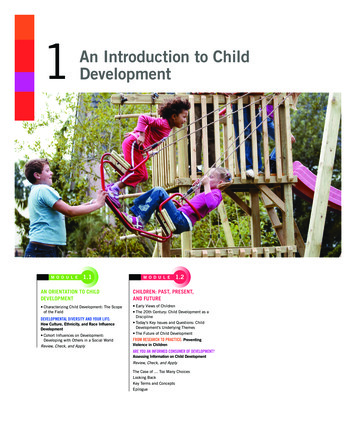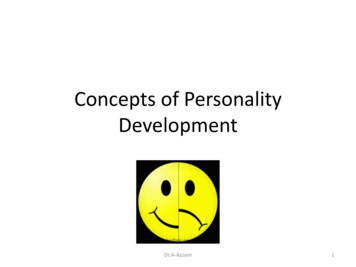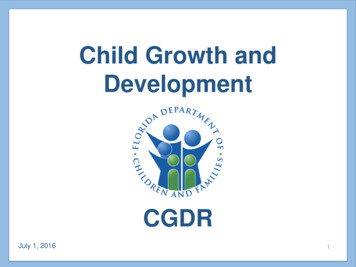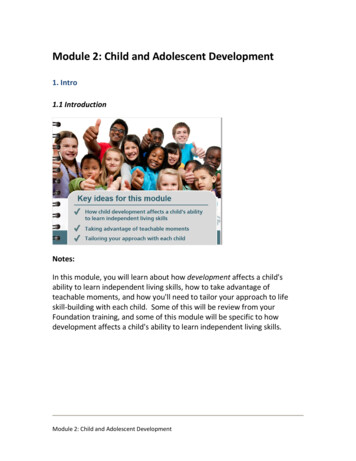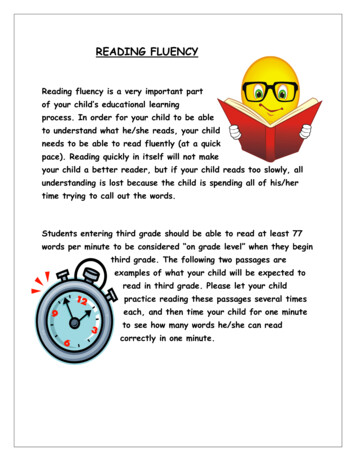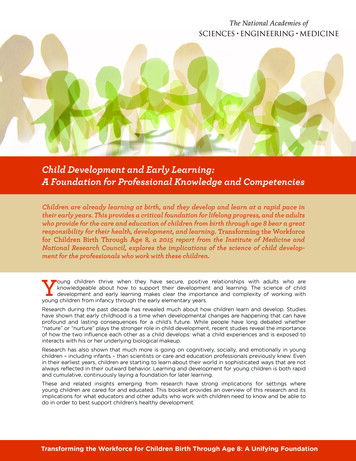
Transcription
Child Development and Early Learning:A Foundation for Professional Knowledge and CompetenciesChildren are already learning at birth, and they develop and learn at a rapid pace intheir early years. This provides a critical foundation for lifelong progress, and the adultswho provide for the care and education of children from birth through age 8 bear a greatresponsibility for their health, development, and learning. Transforming the Workforcefor Children Birth Through Age 8, a 2015 report from the Institute of Medicine andNational Research Council, explores the implications of the science of child development for the professionals who work with these children.Young children thrive when they have secure, positive relationships with adults who areknowledgeable about how to support their development and learning. The science of childdevelopment and early learning makes clear the importance and complexity of working withyoung children from infancy through the early elementary years.Research during the past decade has revealed much about how children learn and develop. Studieshave shown that early childhood is a time when developmental changes are happening that can haveprofound and lasting consequences for a child’s future. While people have long debated whether“nature” or “nurture” plays the stronger role in child development, recent studies reveal the importanceof how the two influence each other as a child develops: what a child experiences and is exposed tointeracts with his or her underlying biological makeup.Research has also shown that much more is going on cognitively, socially, and emotionally in youngchildren – including infants – than scientists or care and education professionals previously knew. Evenin their earliest years, children are starting to learn about their world in sophisticated ways that are notalways reflected in their outward behavior. Learning and development for young children is both rapidand cumulative, continuously laying a foundation for later learning.These and related insights emerging from research have strong implications for settings whereyoung children are cared for and educated. This booklet provides an overview of this research and itsimplications for what educators and other adults who work with children need to know and be able todo in order to best support children’s healthy development.Transforming the Workforce for Children Birth Through Age 8: A Unifying Foundation
The Biology of Early Child DevelopmentResearch in developmental biology and neuroscience offers four broad insights about the role of thedeveloping brain and other biological systems in early childhood development: The developmental window (rapidity of brain development during early childhood). The brain develops through a dynamic interaction between underlying biologi-cal processes and exposures and experiences in the environment. This process beginsat conception and continues throughout life. During a child’s early years, the braindevelops in rapid and fundamental ways, and connections among neurons are reinforced. Because of this, early childhood is a window of both great risk of vulnerabilityto disruption and great potential for the impact of positive developmental influences. The interplay of genes and environment. In many or even most cases, the causesof healthy, normal development – as well as disease, disorders, and developmentalproblems – are best viewed as an interplay between genes and environment. While achild’s genetic makeup has an influence on how strongly he or she is affected by someenvironmental factors or experiences, emerging research also shows that influences inthe environment can shape whether genes are turned off or on. Neither environmentnor biology alone is destiny. The impact of stress on development. There is now strong evidence that early psy-chological and social adversities – beginning even during fetal development – can haveimportant short- and long-term effects on the brain’s development and the way thebrain and body handle stress. In addition to the brain, multiple systems are involved inthe response to stress and can be affected by chronic adversity, including the immunesystem and the endocrine system. While enriching experiences in the early years willsupport healthy brain development, disturbances or deficiencies before birth or in early childhood can interrupt or alter the growing brain, resulting in changes that rangefrom subtle incapacities to generalized developmental disabilities. Examples of serious stressors faced by many children include abuse or neglect, thedeath of a parent, food insufficiency, housing instability, a parent living with mentalillness, or exposure to conflict or violence in the home or neighborhood. Althoughchildren at any socioeconomic level can experience stressors, children in marginalizedpopulations or who experience chronic economic adversity face a disproportionaterisk of experiencing a confluence of multiple sources of chronic stress. Individual differences in sensitivity to environments. There are substantial individu-al differences in how susceptible children are to influences in their environment. Someindividuals seem more sensitive to both positive and negative influences; others survive challenging environments and seem to thrive with little detrimental effect.Together, these four broad insights have reshaped understanding of the formative experiences of childrenin their families, communities, health care settings, childcare and preschool centers, and schools. Theseinsights also have implications for those who educate and care for young children – and they make clearthe complexity and importance of this role.2 TRANSFORMING THE WORKFORCE FOR CHILDREN BIRTH THROUGH AGE 8: A UNIFYING FOUNDATION
Together with the research in developmental biology and neuroscience, research in developmental, cognitive, and educational psychology has contributed to a greater understanding of the developing child.The picture that has emerged is remarkably complex and reveals that many aspects of development andlearning are interrelated. For example, a child relies on developing an ability to regulate emotions andattention in order to concentrate and stay engaged long enough to learn new ideas and skills.Similarly, while certain skills and concepts are distinct to particular subject areas, learning in these subjectareas also relates to general cognitive skills such as reasoning, attention, and memory. Learning is also influenced by a child’s developing relationships with adults and peers. A child’s security both physically andin relationships creates the context in which learning is achievable. Physical health matters as well; studieshave linked food insecurity among children and their families to poor academic outcomes, for example,while increased physical activity has been linked to improved academic performance.Keeping in mind that there are multiple interrelated and mutually reinforcing aspects of child development, the sections that follow describe developmental processes in three areas:1. General cognitive development,2. Subject-area learning, and3. Social and emotional development.Please see Chapter 3, The Interaction of Biologyand Environment, in Transforming the Workforcefor Children Birth Through Age 8: A UnifyingFoundation to learn more about the biology of earlychild development.CHILD DEVELOPMENT AND EARLY LEARNING: A FOUNDATION FOR PROFESSIONAL KNOWLEDGE AND COMPETENCIES3
Supporting Children’s Cognitive DevelopmentStudies of cognitive development have led researchers to understand the developing mind as astonishingly active and insightful from a very young age. As early as infancy, for example, children derive theoriesto explain the behavior of people and the actions of objects. Being aware of what research has discoveredabout babies’ and young children’s cognitive development can help adults who work with children bettersupport their learning.Infants and toddlersResearch has shown that what is going on in babies’ and young children’s minds is much more complexand sophisticated than their outward behavior reveals. Early learning occurs on two levels: the growth ofknowledge that is visible and apparent – language learning, for example, and learning about how objectswork – and the growth of implicit learning, which is harder to observe.Many of the strikingly competent and insightful things going on in young children’s minds are not transparent in their behavior. Because of this, the cognitive abilities of young children are easily underestimated.Some of the recent research has shown that even very early, children: Have a “theory of mind.” Babies have a capacity to reason about and understand themental lives and intentions of others. For example, when 1-year-olds are faced withsomething or someone unfamiliar, they look at their mothers to read her expression todetermine whether the unfamiliar person or object is benign or dangerous. Babies asyoung as 14 months old who see an adult struggling to reach for an object will interrupt their play to crawl over and hand the object to the adult. Have theories of numbers. Even babies seem capable of intuitively understandingsomething that approximates addition and subtraction, and they are surprised whensomething counter to these principles occurs. For example, when babies see an object that is then screened from view and then they see that another object is placedbehind the screen, they are surprised when the screen is lowered if there is only oneobject there. Can make inferences about cause and effect. Young children can experience obser-vations and learning that allow them to conclude that a particular factor X causes(or prevents) an effect Y. In one study, for example, preschool children were shown amachine and told that “blickets” make the machine go. Block A placed on the machinealways made it go. Block B was associated with the machine turning on but only whenBlock A was also on the machine. Children correctly identified Block A as the “blicket”and not Block B. They were also able to intervene correctly to make the machine stopby removing Block A and not Block B. Are sensitive to the statistical probability of events. In one set of studies, for example, 11-month-old babies were shown an opaque box full of many red balls and only afew white balls. The babies showed surprise when balls were poured out of the boxand all of them happened to be white, or when someone reached into the box andhappened to retrieve all white balls. The babies were registering the low proportion ofwhite balls and recognizing the improbability of these events. However, if the experimenter looked into the box as she picked up the balls, the babies were not surprisedif all white balls were selected. This suggests that babies’ implicit knowledge of theoryof mind – in this case, understanding that a person can deliberately select objects –will trump their reasoning about statistical likelihood.4TRANSFORMING THE WORKFORCE FOR CHILDREN BIRTH THROUGH AGE 8: A UNIFYING FOUNDATION
Are sensitive to teaching cues. As early as infancy, children devote special attentionto social situations that are likely to represent learning opportunities because adultscommunicate their intention to teach something. When adults make eye contact, calla baby’s name, and point for the baby’s benefit, these signals lead babies to recognizethat someone is teaching them, and this awareness can affect how and what theylearn.These research findings need to be part of the core knowledge that influences how care and educationprofessionals support young children’s learning. In the past, the prevalent belief that children are “concrete” thinkers – they cannot deal with abstraction or reason hypothetically – led educators to focus onsimple, descriptive activities and miss opportunities to explore cause and effect, theories of numbers, andstatistical probability.Educators can support the growth of these cognitive abilities – for example, by using an abundance ofchild-directed language during social interaction, by playing sorting and counting games (for example,while stacking blocks), by putting words to why somebody looks sad, and by exploring together whathappens when objects collide. These and other shared activities build on understandings that young children are implicitly developing.Relationships and Early LearningThe relationship of an adult to a child – the emotional quality of theirinteraction, the experiences they share, the adult’s beliefs about thechild’s capabilities – helps motivate young children’s learning and inspiretheir self confidence. Commonplace interactions provide contexts forsupporting the development of cognitive and learning skills and theemotional security in which early learning thrives. Applauding a toddler’sphysical skills or a second grader’s writing skills, counting togetherthe leaves on the sidewalk or the ingredients of a recipe, interactivelyreading a book, talking about a sibling’s temper tantrum or an episodeof classroom conflict between children – these and other sharedexperiences contribute to young children’s cognitive development andearly learning.Preschool and early elementary yearsDuring these years, children’s learning is more explicit and visible. Preschoolers are more competent indeliberate approaches to learning, such as trial and error or informal experimentation. Preschoolers areexperiential, learning by doing rather than figuring things out only by thinking about them. This makesshared activities with educators and peers potent opportunities for cognitive growth.Still, the potential to underestimate the cognitive abilities of young children persists in the preschool andkindergarten years. In one study, for example, children’s actual performance was six to eight times whatwas estimated by their own preschool teachers as well as experts in educational development. A study inkindergarten revealed that teachers spent most of their time on content the children already knew.When educators practice in a way that is aware of the cognitive progress of children at this age they candeliberately enlist the child’s existing knowledge and skills in new learning opportunities. Greater achievement in this age group is associated with instructional strategies that promote higher-level thinking,creativity, and some abstract understanding, such as talking about ideas or future events. For example,when educators point out how numbers can be used to describe diverse sets of elements (four blocks,four children, 4 o’clock), it helps children generalize an abstract concept (“fourness”). Another exampleis interactive storybook reading, in which children describe the pictures and label their elements whilethe adult and child ask and answer questions of each other about the narrative. Preschoolers’ interest inlearning by doing is also naturally suited to experimental inquiry related to science and other types oflearning that involve developing and testing hypotheses.CHILD DEVELOPMENT AND EARLY LEARNING: A FOUNDATION FOR PROFESSIONAL KNOWLEDGE AND COMPETENCIES5
In the early elementary years, children are using more complex vocabulary and grammar. They are growing in their ability to make mental representations, although they still have difficulty grasping abstractconcepts without the aid of real-life references and materials. At these ages, children are also increasinglyable to understand and manage their emotions. They make sense of their own feelings more and more,and learn better ways to describe experiences and express thoughts and feelings. This increasing abilityto manage their thoughts and feelings also means that they have a greater ability to follow instructionsindependently in a manner that would not be true of preschool or younger children. Educators can relyon children’s growing cognitive abilities to use instructional approaches that depend on children’s ownindependent discoveries, their use of alternative strategies for inquiry, and their greater persistence inproblem solving.Please see Chapter 4, Child Development andEarly Learning, in Transforming the Workforcefor Children Birth Through Age 8: A UnifyingFoundation to learn more about supportingchildren’s cognitive development.6TRANSFORMING THE WORKFORCE FOR CHILDREN BIRTH THROUGH AGE 8: A UNIFYING FOUNDATION
Supporting Subject-Area LearningSome principles for instructional practices are generally applicable across subject areas and across different domains of development and learning, such as: Teaching through learning trajectories. Children learn in a developmental sequenceas they progress through increasingly sophisticated levels of thinking and understanding of concepts as well as mastering skills. Well-designed curricula are thereforebased on developmentally sequenced activities. Quality instructional practice requiresthat educators understand and employ three components of learning trajectories: (1)the subject-matter content itself, (2) the developmental progression of how children’sthinking and understanding grows as they learn particular content, and (3) the instructional tasks and strategies that promote learning along that progression. Educators also need to be able to assess the progress of groups and individual children andto adjust the learning environment and instructional activities accordingly. Using a mix of instructional methods. Debates about instruction often treat differ-ent methods as dichotomous or in opposition, but effective instructional approachesactually serve children best when multiple complementary instructional strategies areused in combination – for example, when instructor-led teaching is alternated withactivities in which children learn cooperatively with one another. Using tiered intervention approaches. In these approaches, educators use ongoingassessment methods to identify which children have learned particular content ormastered specific skills and which children might benefit from additional instructionfor that set of proficiencies. These additional learning opportunities are offered one onone or in small groups with more intensive instructional support. Ensuring continuity and alignment. The development and learning of young childrendepends on continual, cumulative support. Early progress as a result of high-qualityearly childhood experiences may be weakened by later settings that do not have thesame quality or that, for example, focus on lower-level skills, assume children have lowlevels of knowledge, and/or have low expectations for certain children. Similarly, theeffects of high-quality instruction in elementary school can be hampered by children’slack of prior exposure to foundational, high-quality learning experiences. For this reason, goals and approaches need to be aligned across early childhood and elementarysettings. Continuity is facilitated when rigorous, evidence-informed standards, curricula, assessments, and teaching practices are coherently aligned with each other andacross ages and grade levels.I n addition to these general principles, every subject area also requires that children acquire specificcontent knowledge and skills – and correspondingly, that educators have specific knowledge and competencies in instructional and assessment practices. Two core subject areas – language and literacy andmathematics – are discussed further here because they are foundational for other subject areas and forlater academic achievement. How they are learned has been extensively studied in young children, compared to other subject areas.Language and literacyThe oral language and vocabulary children learn through interactions with parents, siblings, caregivers,and educators provide the foundation for later literacy and learning across all subject areas. Children benefit from extensive opportunities to listen to and use complex spoken language. The more often adultsuse particular words in conversation with young children, the sooner children will use those words in theirown speech.CHILD DEVELOPMENT AND EARLY LEARNING: A FOUNDATION FOR PROFESSIONAL KNOWLEDGE AND COMPETENCIES7
Research in early childhood classrooms serving children from low-income backgrounds suggests thatdaily high-quality language building experiences may be rare. Even small improvements in the literacyenvironment can have especially strong effects for these children.Infants and toddlersEducators serving infants and toddlers can use several key strategies to foster effective environments forlanguage learning.Use language-based interactions to develop trusting bonds. Consistently responding to infants’ andtoddlers’ communication with talk and encouragement that is emotionally attuned is crucial for earlylanguage development. At this stage of development, it is particularly important that these language interactions be responsive to children’s emotional expressions, such as laughter or crying, and expressionsof need.Use talk for learning. Language development is supported by ongoing exposure to elaborate language,as well as simple requests and questions that draw out children’s first words and phrases. Educatorscan create high-quality language environments by intentionally and thoughtfully using their own talk –through explanations, questioning, and descriptions – to build up the knowledge of those in their care.Instructional use of talk can include “narrating” events of the day (for example, “We’re crossing the roadto get to the park.”) and describing children’s actions as they are performing them (“You’re putting yourhand in the warm mitten.”). Using talk for learning also involves extending children’s language by supplying additional words and more complex sentence structures (for example, when a child says “Up!” thensaying “You want me to pick you up?”).Using talk for learning is most effective when early educators engage in discussions of the here and nowthat also take young children beyond their immediate surroundings and experiences. An educator mightbegin with the here and now (for example, a child’s expression of interest in an object); expand from there(talking about the object’s appearance or what one can do with it); and then engage in talk that goesbeyond the immediate context ( making a plan for using the object later in the day or discussing a prioruse of the object). In this example, the educator is responding to children’s interests and real-time experiences, situating language learning in meaningful contexts.It is also important for educators to engage groups of children in extended discourse. This should includeasking and discussing open-ended questions, which require more than a “yes” or “no” and prompt reflection. Educators should encourage children to take turns responding, as well as monitor the group toinvolve nonparticipating children.Engage in language-rich play. Play is a means of learning in early childhood, and educators should beable to weave language learning throughout the play of young children. Educators can and should usesongs and gestures, flannel board stories, puppets, and other materials that prompt the use of talk bychildren and adults alike. Language-rich play includes not only adult–child interactions, but also – beginning as early as toddlerhood – groups of children. When facilitating play among groups of toddlers, educators should intentionally support and guide the language experience – for example, by narrating eventsand using strategies to encourage peer interactions.Read a variety of books and reread favorites. Children become “readers” long before they begin to read.Educators should make reading aloud with children part of the daily routine. Regular exposure to thistype of shared book reading will build children’s language as well as their interest in print. This is another chance to be emotionally attuned and strengthen bonds with young children. Interactive storybookreading with children – in other words, having conversations as stories are read – is one of the best-documented methods for improving the vocabularies of children.8TRANSFORMING THE WORKFORCE FOR CHILDREN BIRTH THROUGH AGE 8: A UNIFYING FOUNDATION
Preschool and early elementary schoolLanguage and literacy development is a major focus of instruction in prekindergarten and K-3 classrooms.Primary grade educators tend to be strong in certain aspects of effective language and literacy instruction, such as word-reading skills. However, other areas – especially vocabulary, reading comprehension,and conceptual and content knowledge – are not as emphasized, especially in the use of informationaltexts that would enhance early reading skills.Research has shown that in high-quality classroom language environments educators use a variety ofabstract words and complex sentences. Whether teachers are providing directions, reviewing information, or posing questions, sophisticated talk permeates classroom instruction and conversation. In suchenvironments, children also participate in content-based discussions and purposeful play and above all,have the chance to talk (and talk and talk).The following are three strategies educators can use to strengthen the quality of classroom languageenvironments.Organize classroom learning around content-based and multifaceted units of study. Learning throughextensive study of a topic is a hallmark of effective language and literacy instruction in these years. Forexample, thematic units organized around multifaceted topics elicit the use of complex vocabulary byteachers and are one way to foster complex language knowledge among children. Each unit should revolve not only around content-rich themes, but also around a complementary, small set of target vocabulary words that lend themselves to talking and writing throughout the unit. These words should be academic in nature – more commonly used in academic content areas than in day-to-day conversation – andconceptually abstract, therefore requiring study and extended discussion to promote an understandingof the concepts and ideas they represent.Vary instructional groupings so that children have regular, frequent opportunities for extended conversations with their peers and teachers. Different instructional groupings – whole group, small group,and pairs – lend themselves to different kinds of language experiences, all of which combine to makea high-quality classroom language environment. In particular, pairs and small groups provide childrenwith the opportunity to participate in strong language experiences. When instruction involves pairs orsmall groups, it is important to (1) plan groupings that strategically support language development – forexample, grouping children of different language skills together so that children with stronger languageskills model use of language for peers with more limited language skills; and (2) guide and support peerinteractions – for example, assigning and posting visuals that display steps. In all cases, it is important tooffer children topics to discuss and/or protocols for conversation.It is also important for children to have regular, frequent opportunities to participate in educator-facilitated small-group discussions – back-and-forth conversations in which the educator builds on and extendsstudents’ language and ideas. The whole day is filled with moments ripe for planned and spontaneousteaching and learning moments. Back-and-forth conversations can be incorporated into many aspects ofthe daily schedule – even during routines such as hand washing, lining up, and gathering belongings. Forexample, educators might provide daily questions for children to think about as they engage in a transition – for example, lining up to go down the hall – and then have children share their responses with apartner when they reach their destination.Use read-alouds as a platform for conversation. Interactive readings of a variety of books related to thecontent under study increases the quality of the language environment in at least two ways. First, thewritten language often stands in contrast to conversational, and even instructional, language. Second,classroom read-alouds are foundational for spurring content-rich classroom discussions. The content ofhigh-quality children’s books – both fiction and informational texts – lends itself to discussion of topics inthe sciences, social studies, and the arts, all of which spur the use of academic and sophisticated words.CHILD DEVELOPMENT AND EARLY LEARNING: A FOUNDATION FOR PROFESSIONAL KNOWLEDGE AND COMPETENCIES9
MathematicsIf given opportunities to learn, young children possess a remarkably broad, complex, and sophisticated– albeit informal – knowledge of mathematics. In their free play, almost all preschoolers engage in substantial amounts of pre-mathematical activity. They count objects; compare magnitudes; and explorepatterns, shapes, and spatial relations.Children’s early knowledge of mathematics is surprisingly important and it strongly predicts later successin mathematics. Mathematical thinking reaches beyond competence with numbers and shapes to forma foundation for general cognition and learning. Difficulties with math are a strong predictor of failure tograduate high school. Given its importance, children need a robust foundation in mathematics knowledgein their earliest years.However, mathematics is generally not taught well to young children. Preschool educators tend not tosupport mathematics learning and when they do it is often of a low quality. Most early childhood educators in the United States receive weak preparation for teaching mathematics, which may in part be due totheir having a low level of mathematics knowledge prior to their choosing to pursue teaching as a profession. Because content knowledge is a prerequisite for knowing how to teach the content, increasing themathematics knowledge of early childhood educators needs to be a priority.Mathematical learning trajectoriesChildren
child development and early learning: a foundation for professional knowledge and competencies 3 Together with the research in developmental biology and neuroscience, research in developmental, cog- nitive, and educational psychology has contri


